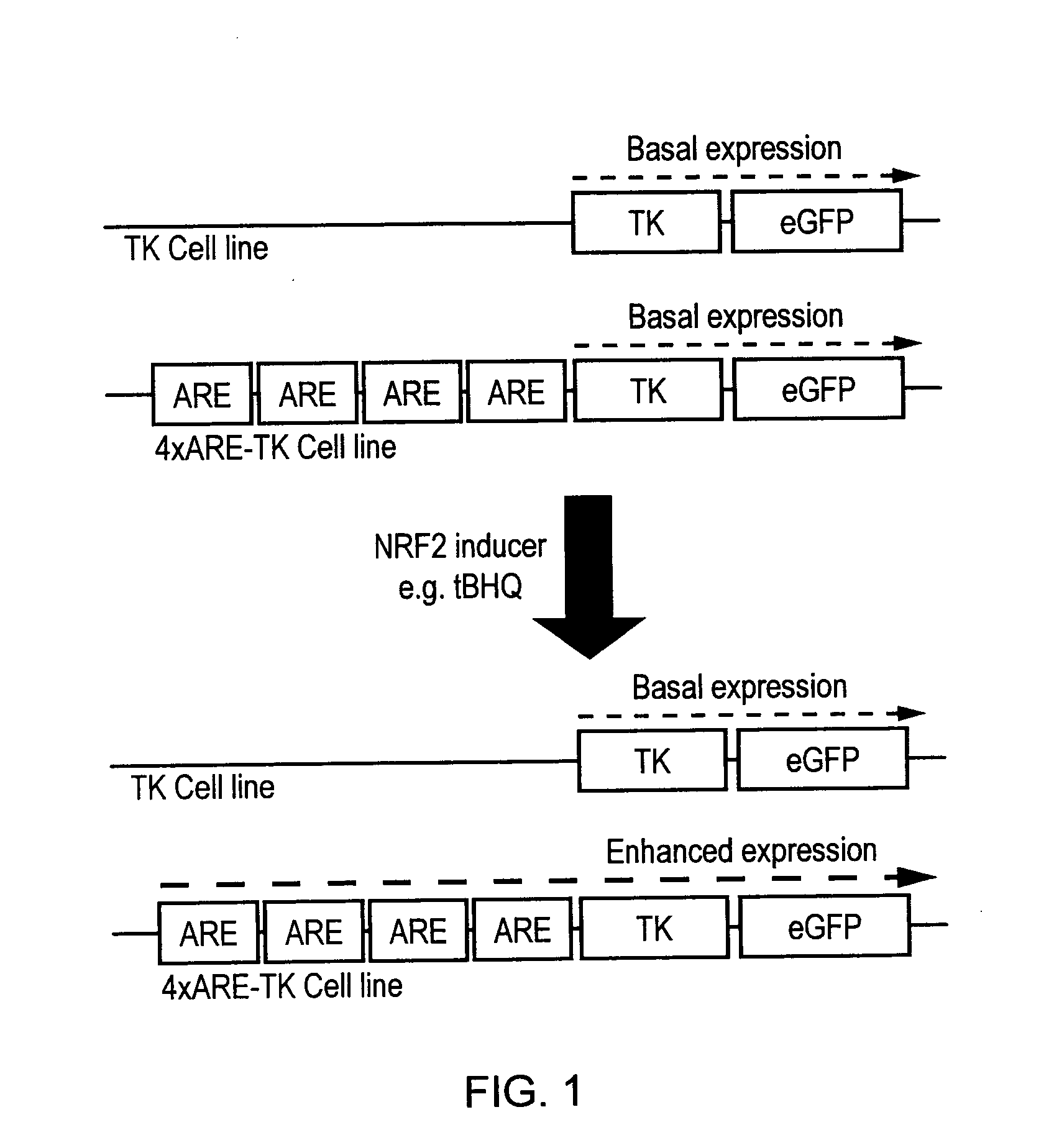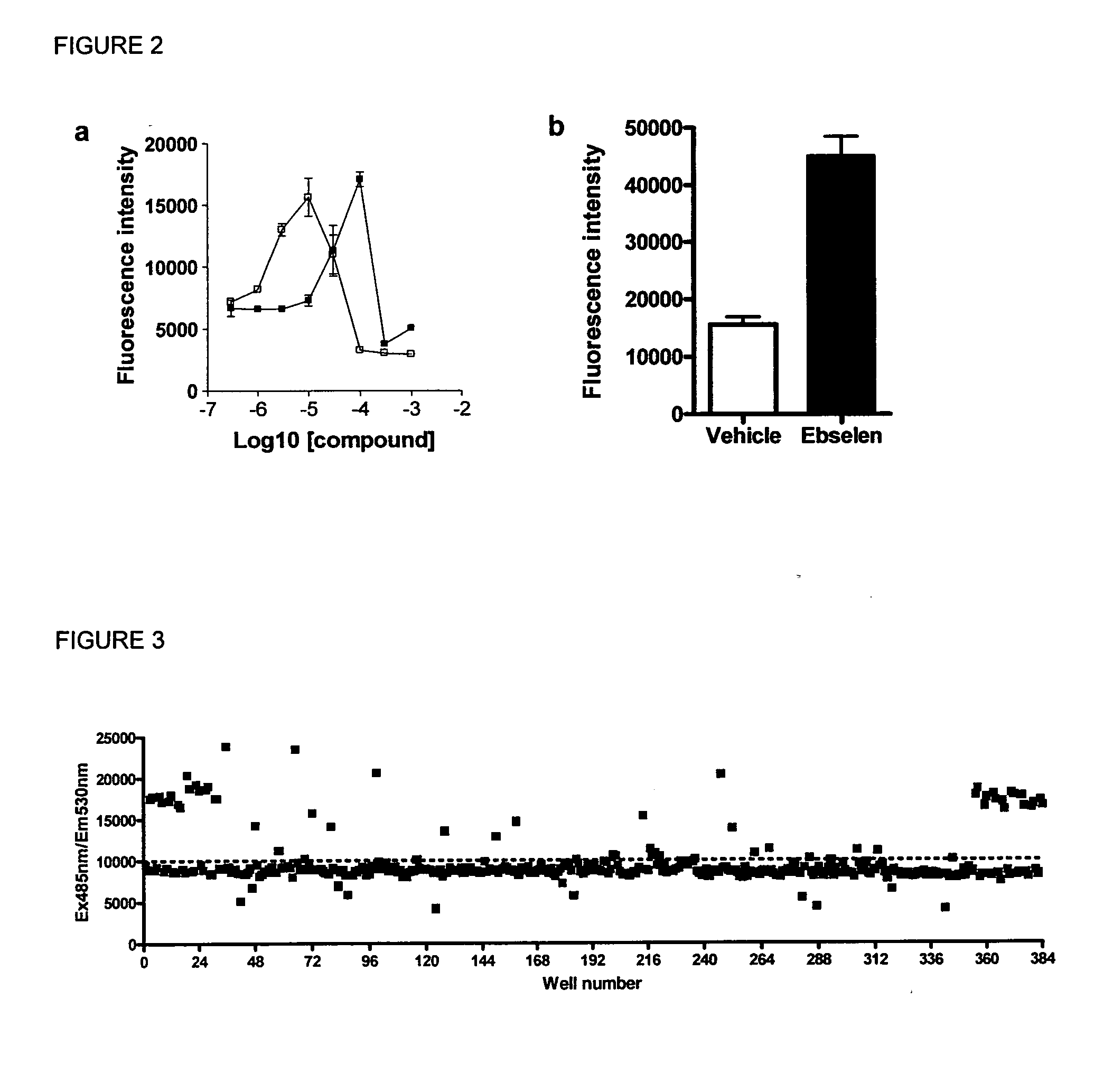Therapeutics for neurological disorders
a neurological disorder and therapy technology, applied in the field of neurological disorders, can solve the problems of not achieving clinical benefits for patients, no treatment which prevents or reverses the course of the disorder, and extending survival to a modest degree,
- Summary
- Abstract
- Description
- Claims
- Application Information
AI Technical Summary
Benefits of technology
Problems solved by technology
Method used
Image
Examples
example 1
[0090]The 4×ARE-TK-GFP and TK-GFP reporter cell lines were tested for their response to the known ARE inducers tert-Butyl Hydroquinone (tBHQ) and the flavonoid EGCG at a range of concentrations. The compounds were applied in triplicate to confluent cells in 96 well plates in serum free medium for 24 hours and the induction of GFP measured in a fluorescence plate reader. Both compounds induced GFP expression in a narrow window, with EGCG peaking at 100 μM and tBHQ peaking at 10 μM (FIG. 2a). At concentrations higher than this peak expression, both compounds showed signs of toxicity by direct observation (cell loss) or increased Ethidium Homodimer fluorescence. No increase in fluorescence was seen in the control TK-GFP cell line (not shown).
example 2
[0091]In order to screen the SPECTRUM collection of 2000 molecules the reporter assay was scaled down to a 384 well-plate format. To assess the suitability of the assay for library screening, a Z′ score calculation was performed by treating alternate wells with vehicle (0.1% DMSO) and 10 μM Ebselen as a positive control (see calculation in Methods). We have shown Ebselen gives a robust concentration response curve in this assay. The calculated Z′ score was 0.51 (FIG. 2b) which is acceptable for library screening. In addition, signal to noise (S / N) and signal to background (S / B) ratios were acceptable at 12.8 and 2.9 respectively. The library was subsequently screened at a single concentration per compound of 10 μM. Drug library dilutions and plating were carried out by a Q-BOT liquid handling system and both the 4×ARE-TK-GFP reporter cell line and TK-GFP control cell line were tested for their response to the compounds. An example set of data for the ARE-TK-GFP cell line from a sing...
example 3
[0092]The effects of Nrf2-ARE inducing hit compounds on oxidative stress induced by serum withdrawal in motor neuronal and astrocytic cells was investigated. Since the activation of this pathway may vary depending on the cell type, we then went on to screen how well these hit compounds could protect a motor neuronal cell line (NSC34 cells) and rat (C6) and human (1321N1) astrocyte cell lines from oxidative stress induced by serum withdrawal. The cell lines were pre-treated with hit compound at a range of concentrations for 24 hours to activate the NRF2-ARE pathway. The compound was then removed and the cells subjected to a six hour serum withdrawal to induce oxidative stress. The degree of oxidative stress was measured using dichlorofluorescein (DCF) fluorescence and the degree of protection is shown in Table 3 as percentage reduction in DCF fluorescence for each of the three cell lines. Where it was possible to fit a curve, the concentration required to give a half maximal effect (...
PUM
| Property | Measurement | Unit |
|---|---|---|
| Fraction | aaaaa | aaaaa |
| Fraction | aaaaa | aaaaa |
| Fraction | aaaaa | aaaaa |
Abstract
Description
Claims
Application Information
 Login to View More
Login to View More - R&D
- Intellectual Property
- Life Sciences
- Materials
- Tech Scout
- Unparalleled Data Quality
- Higher Quality Content
- 60% Fewer Hallucinations
Browse by: Latest US Patents, China's latest patents, Technical Efficacy Thesaurus, Application Domain, Technology Topic, Popular Technical Reports.
© 2025 PatSnap. All rights reserved.Legal|Privacy policy|Modern Slavery Act Transparency Statement|Sitemap|About US| Contact US: help@patsnap.com



